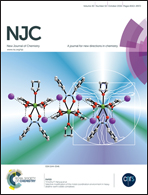A colorimetric sensor based on thiourea–polyvinyl alcohol microspheres for the selective recognition of Hg2+ and Cu2+
Abstract
In this study, an optical analytical naked-eye sensor based on thiourea–polyvinyl alcohol (PVA) microspheres was designed for the selective recognition of heavy metals in aqueous solutions. The colorimetric sensor was characterized by scanning electron microscopy and Fourier transform infrared spectroscopy to confirm the linkage of the chromophore with the surface of PVA microspheres. In the sensing system, notable changes in absorbance intensity of the colorimetric sensor for Hg2+ and Cu2+ were observed at pH 3 and 4, respectively. The sensor could selectively recognize heavy metals, as shown by the change in color from faint yellow to orange for Hg2+ and from faint yellow to dark green for Cu2+. The sensor provided consistent data reliability, with a detection limit of 0.209 and 0.320 μM by UV-vis spectrometry for Hg2+ and Cu2+, respectively. The prepared colorimetric sensor can be used to monitor Hg2+ and Cu2+ with satisfactory results because of its selectivity, reversibility, sensitivity, and signal stability.


 Please wait while we load your content...
Please wait while we load your content...